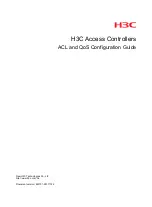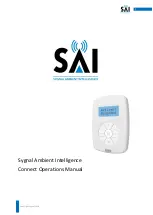
NOTE:
Comfort Zone uses a 3-minute timer to delay start of
second-stage (heating or cooling). This timer is started whenever
first-stage heating or cooling is energized. This delay cannot be
overridden or disabled.
STAGE CONTROL DURING EQUIPMENT OPERATION
As shown earlier, Comfort Zone has 6 configurable options which
help govern equipment operation. They are:
1. Comfort Trend Staging (Rotary Position T-8).
2. System Mode Reselect (Rotary Position T-22).
3. High/Low Temperature Limits Enabled (Rotary Position
T-10).
4. High Temperature Trip Limit (Rotary Position S-6).
5. Dx Sensor (Rotary Position T-27).
6. Smart Start (Heat Pump Strip Heat Economy Feature)
Comfort Trend Staging and High/Low Temperature Limits
control the use of extra stages of heating and cooling. Both can be
turned off by the installer but the use of these options is highly
recommended.
Comfort Trend Staging is used by Comfort Zone as an aid to
decide if second-stage (heating or cooling) is needed. The system
must have at least 1 zone with a demand equal to or greater than
2.0
o
F to allow use of second stage. Comfort Trend looks at
temperature inside zone and watches trend over time. If zone
demand is being lowered by first-stage operation, second stage is
not energized. Stage 1 would remain ON and Stage 2 would
remain OFF as long as temperature and trend continued to
improve.
Comfort Trend Staging uses a 6-minute timer and a record of the
Reference Zone demand to control second stage. When Comfort
Trend Staging starts, demand in Reference Zone is recorded and
temperature in zone is continuously monitored. If demand in
Reference Zone is reduced (temperature is approaching comfort
setpoints), then 6-minute timer is restarted and new demand is
recorded. If 6-minute timer expires and demand is the same or has
grown greater, Comfort Zone will start second stage.
Comfort Trend works for all stages of heating and cooling
operation.
Comfort Trend staging will be used if rotary Position T-8 is turned
ON. If T-8 is turned OFF, then second stage will be energized
whenever Reference Zone demand meets or exceeds 2.0°F and
after 3-minute delay.
System Mode Reselect allows Comfort Zone to switch between
heating and cooling even if current system demand has not been
satisfied. For example, if Comfort Zone is providing heat, System
Mode Reselect allows Comfort Zone to look at any cooling needs
which may also exist in the building. If cooling demand exceeds
heating demand for 20 minutes, Comfort Zone will stop providing
heat and switch into a cooling mode. Once cooling demand is
satisfied (or System Mode Reselect dictates a switch), Comfort
Zone will revert to a heating mode in order to try and satisfy that
demand.
The need for System Mode Reselect usually indicates some type of
system problem. Common use of System Mode Reselect may be
caused by poor or improper duct work, open windows or doors,
HVAC equipment failure, improper equipment sizing, etc. The
need for System Mode Reselect usually occurs in larger installa-
tions where zone use or occupancy may vary widely. For residen-
tial application, the need for System Mode Reselect is normally not
frequent unless the building has unusual architectural features or
problems with HVAC system.
High/Low Temperature Limits is an option that allows Comfort
Zone to control equipment stages and position dampers based upon
temperature of supply air leaving HVAC equipment. As the
Comfort Zone system operates through a heating or cooling cycle,
zone demands and damper positions will change. This changes
actual tonnage or BTUH that is applied to HVAC equipment. The
tonnage generated by HVAC equipment must equal tonnage
placed into zones. If zone’s airflow decreases, cooling equipment
will tend to drive down supply air temperatures. Conversely,
heating equipment will tend to drive up supply air temperatures.
With High/Low Temperature Limits turned ON, Comfort Zone
will detect this condition and take corrective action. The first step
taken by Comfort Zone will be to start turning off extra stages of
equipment. this will continue until either the Leaving Air Tem-
perature problem is corrected or system is operating on first-stage
heating or cooling only.
If system is operating on first-stage heating or cooling, Comfort
Zone will begin to gradually open zone dampers. This can continue
until system has become a fully-open constant-volume system if
needed. The objective is to provide required heating or cooling as
best as possible prior to shutting off equipment. In practice the
control tends to match equipment capacity to zone demands and
will seldom revert back to a fully-open system.
The Leaving Air Temperature control can also indicate problem
zones within a system which are not receiving sufficient airflow. If
1 area (or zone) within a building has difficulty becoming satisfied
then there may be a sizing problem or an obstruction in duct work
supplying that zone.
To use the Leaving Air Temperature Control, 3 options must be
setup properly. They are:
1. High/Low Temperature Limits Enabled (Rotary Position
T-10).
2. High Temperature Trip Limit (Rotary Position S-6).
3. Dx Coil Sensor For Leaving Air Temperature Checking
(Rotary Position T-27).
First, High/Low Temperature Limits Enabled must be turned
ON. This is the ON-OFF switch for the control option. The
temperature used for this control is measured by Remote Duct
Sensor and (optionally) the Dx Coil Sensor.
The High Temperature Trip Limit (Rotary Position S-6) is
supply air temperature for heating that the Leaving Air Tempera-
ture control uses to detect a problem during heating modes only.
The Comfort Zone thermostat will display a number between 05
and 55°F. The actual temperature is 100°F greater, such that the
actual range is 105°F to 155°F. Comfort Zone cannot display the
100’s digit.
Selecting the Offset Temperature picks the temperature when
Comfort Zone will start taking action to correct the Leaving Air
Temperature. If limit temperature is between 105°F and 109°F,
Table 5—HVAC Equipment Stages
Vs. Zone Demand
HEATING & COOLING
EQUIPMENT STAGES
DEMAND °F
DEMAND °C
First-Stage Cooling
1.5
0.83
Second-Stage Cooling
2.0
1.11
First-Stage Heating
1.5
0.83
Second-Stage Heating
2.0
1.11
Third-Stage Heating
2.5
1.39
Fourth-Stage Heating
3.0
1.67
11












































